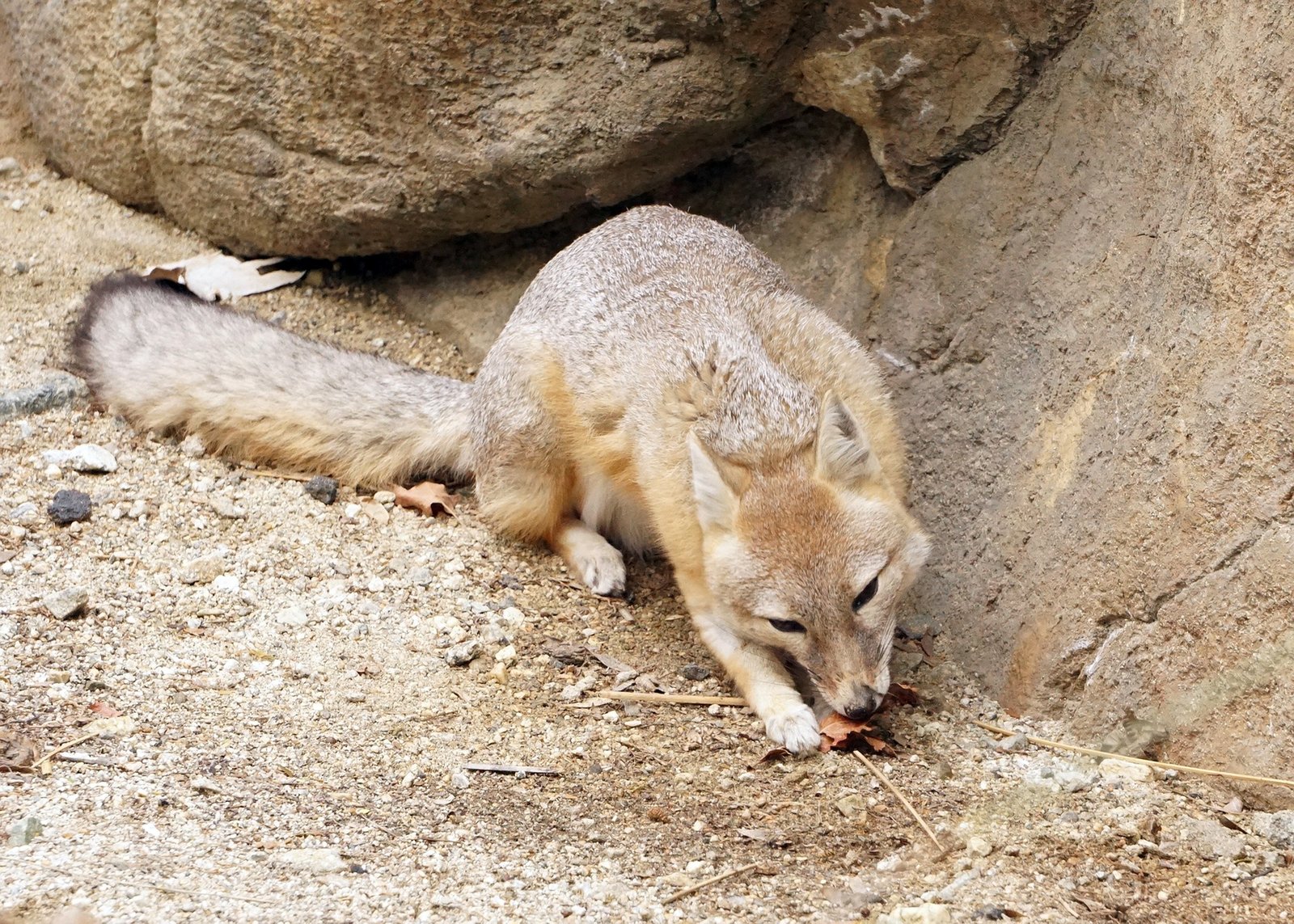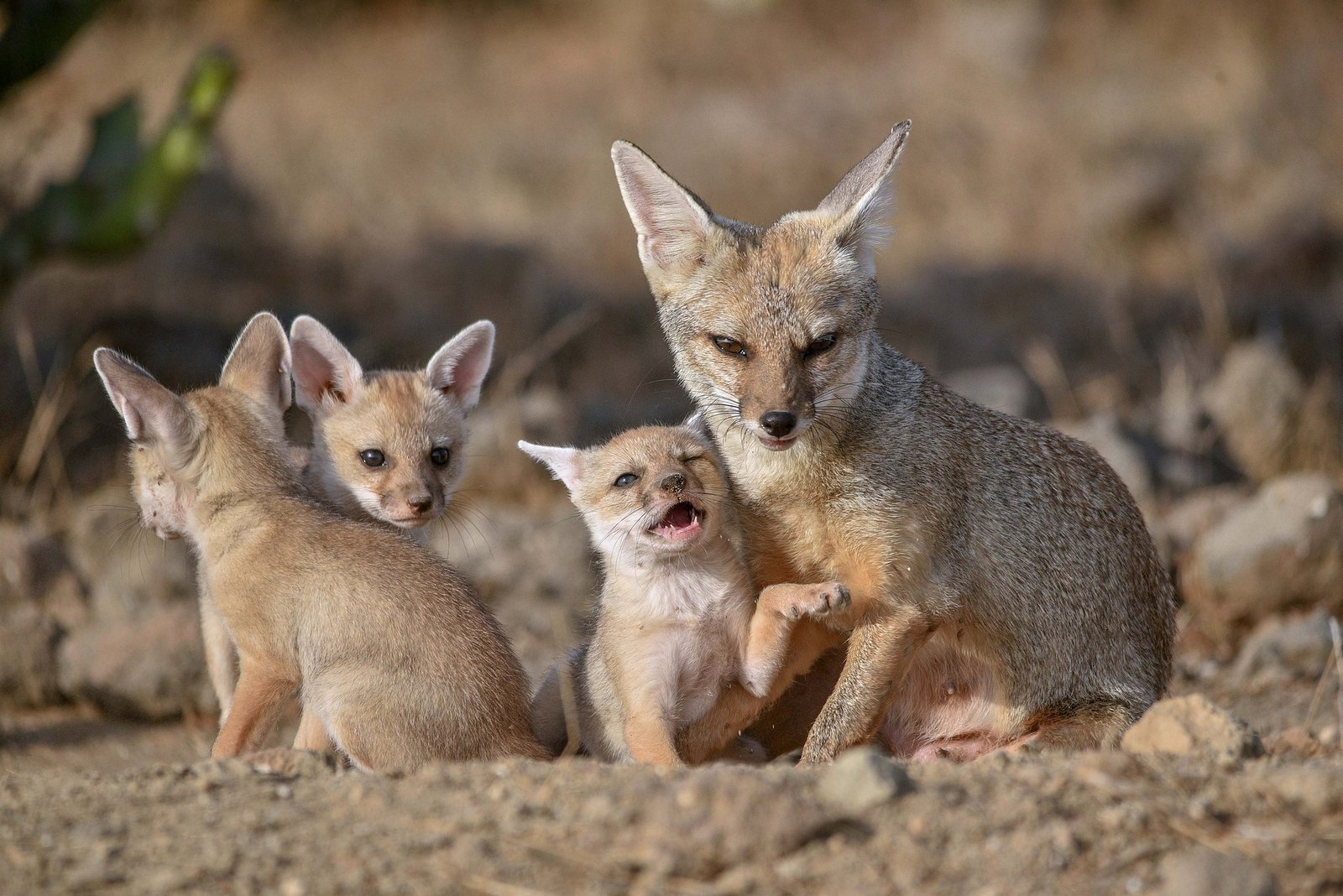Kit Fox: Vulpes Macrotis

Description Of The Kit Fox
One of the smallest species of the Canidae family found in North America is the kit fox.
It has large ears, ranging from 2.8 to 3.7 inches, that help the fox reduce its body temperature and give it exceptional hearing (much like those of the fennec fox). With the male being slightly larger, this species exhibits sexual dimorphism. The species’ median weight is between 3.5 and 6.0 lb and has a body length between 17.9 and 21.1 in. The tail adds an additional 9.8-13.4 to its size.
Usually, it has a gray coat with rusty tones, and its tail has a black tip. It does not have a strip along the length of its tail, unlike the gray fox. Its fur color ranges from yellow to gray, and its back is usually darker than most of its coat; it is generally lighter on its belly and inner ears. Around the nose, it has distinct dark patches. 1Go To Source kids.kiddle.co -“Kit fox facts for kids”
Learn More: Pest Fox Species
Kit Fox Behavior

During hot desert days, kit foxes stay relatively inactive, remaining in their dens. They are mainly nocturnal, but they are also occasionally crepuscular. Kit foxes forage on their own. Kit foxes aren’t exceptionally territorial, preferring to live in pairs or small family groups in underground burrows. Neighboring family groups’ territories can overlap. Females are considered to be relatively dormant, with males appearing to disperse more widely.
Kit foxes have huge ears and excellent hearing performance. In intraspecific encounters, kit foxes sometimes bark at perceived threats or use a “hacking growl.”
Survival rates for Vulpes macrotis depend on food availability, reproduction, and local predators. Different studies of kit foxes have estimated different life expectancies. Some report lifespans of between 3 and 4 years, while others report lifespans of between 7 and 12 years. A study of 144 kit fox pups in California demonstrated a 74 percent mortality rate in puppies within the first year. 2Go To Source animaldiversity.org -“Vulpes macrotis kit fox”
Kit Fox Reproduction Cycle
Kit foxes are found to be monogamous in most studies, with pairs mating for life. Occasional polygyny, wherein a single male may mate with several females, has also been reported.
Females will go out on their own searching for a den when the female is ready to reproduce. Usually, this occurs around the month of September. In October, until the end of the whelping season, the male kit fox will join her and remain with her.
The typical gestation period, giving birth in early spring, is 49 to 55 days. Kit foxes can produce 1 to 7 pups in a litter, with an average of 4. 3Go To Source animalark.org -“Kit Fox, Vulpes macrotis”
Habitat Of The Kit Fox

Kit foxes are adapted to desert and semi-arid habitats over much of the Southwest, inhabiting mixed-grass shrublands, shrublands, and pinyon-juniper woodland margins. The typical habitat consists of salt brush-dominated plant communities in central California, shad scale and creosote bush in the Mohave Desert, and in the Great Basin shad scale, greasewood, and sagebrush.
In lower Colorado and lower Gunnison River drainages, kit foxes captured between 1992 and 1996 in western Colorado were in cold desert shrubland habitats. Kit fox habitat features in Colorado are similar to those in Utah and include grasslands of sage-salt brush, mat salt brush, stands of greasewood salt brush, and shrub-grasslands intermingling with woodlands of pinyon-juniper. 4Go To Source fs.usda.gov -“Kit Fox (Vulpes macrotis): A Technical Conservation Assessment”
Kit Fox Range & Distribution
In the northern/central Mexico and the Southwestern United States, kit foxes are found. The arid interior of Oregon is the northernmost part of their range. The eastern limit is southwestern Colorado. South through Nevada, Utah, southeastern California, Arizona, New Mexico, and into western Texas, kit foxes can be found.
Arid climates, like desert scrub, chaparral, and grasslands, are preferred. In urban and agricultural areas, they can also be found. 5Go To Source animalia.bio -“Kit Fox”
Diet Of Kit Foxes
These small foxes are mainly carnivorous and mostly eat meat, although they occasionally feed on fruits and berries. The Cactus fruit is the most common plant in their diet.
They hunt a wide variety of prey, but their most common targets are rodents. There are rabbits, prairie dogs, rats, mice, jackrabbits, birds, snakes, lizards, and insects, among some of the various animals they hunt. Kits even hunt alone when they live in groups. 6Go To Source animals.net -“Kit Fox”
Kit Fox Predators
- Red Foxes
- Birds Of Prey
- Coyotes
- Feral Dogs
- Bobcats
Conservation & Threats To The Kit Fox Species
In the 1930s, the San Joaquin (SJ) kit fox was once a thriving species, making its home in the Central Valley’s native grasslands. The United States government listed the SJ species as endangered in 1967 and also listed them as threatened in California in 1971.
San Joaquin kit foxes play an important role in the ecosystem. Still, sometimes humans find themselves in conflict with this typically shy and fearful animal because they adapt to changes in the landscape caused by urban development. Bakersfield, Taft, and Coalinga are unique cities because kit foxes have been established in those urban settings. 7Go To Source wildlife.ca.gov -“Keep Me Wild: Kit Fox”
Sources:
- “Kit Fox Facts for Kids.” Kiddle, Kiddle Encyclopedia, kids.kiddle.co/Kit_fox. Accessed 2 Feb. 2021.
- Patton, A. 2008. “Vulpes macrotis” (On-line), Animal Diversity Web. Accessed February 02, 2021 at https://animaldiversity.org/accounts/Vulpes_macrotis/
- Worsley, Alex. “Kit Fox.” Animal Ark, Animal Ark, 18 Jan. 2018, animalark.org/education/learn-about-animals/family-canidae/kit-fox/#:%7E:text=Kit%20foxes%20are%20the%20smallest,family%20Canidae%20in%20North%20America.&text=Kit%20foxes%20range%20in%20color,the%20end%20of%20the%20tail.
- Meaney, C.A., M. Reed-Eckert, and G.P. Beauvais. (2006, August 21). Kit Fox (Vulpes macrotis): a technical
conservation assessment. [Online]. USDA Forest Service, Rocky Mountain Region. Available: http://
www.fs.fed.us/r2/projects/scp/assessments/kitfox.pdf, 2 Feb. 2021. - “Kit Fox – Facts, Diet, Habitat & Pictures on Animalia.Bio.” Animalia, Animalia, animalia.bio/kit-fox. Accessed 2 Feb. 2021.
- Oldham, Cydni. “Kit Fox.” Animals Network, Animals.NET, 10 July 2019, animals.net/kit-fox.
- “Keep Me Wild: Kit Fox.” California Department Of Fish And Wildlife, State of California, wildlife.ca.gov/Keep-Me-Wild/Kit-Fox. Accessed 2 Feb. 2021.
